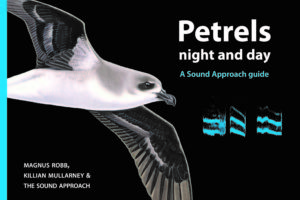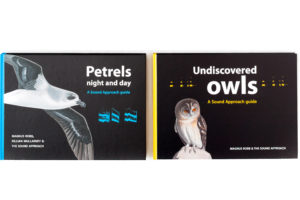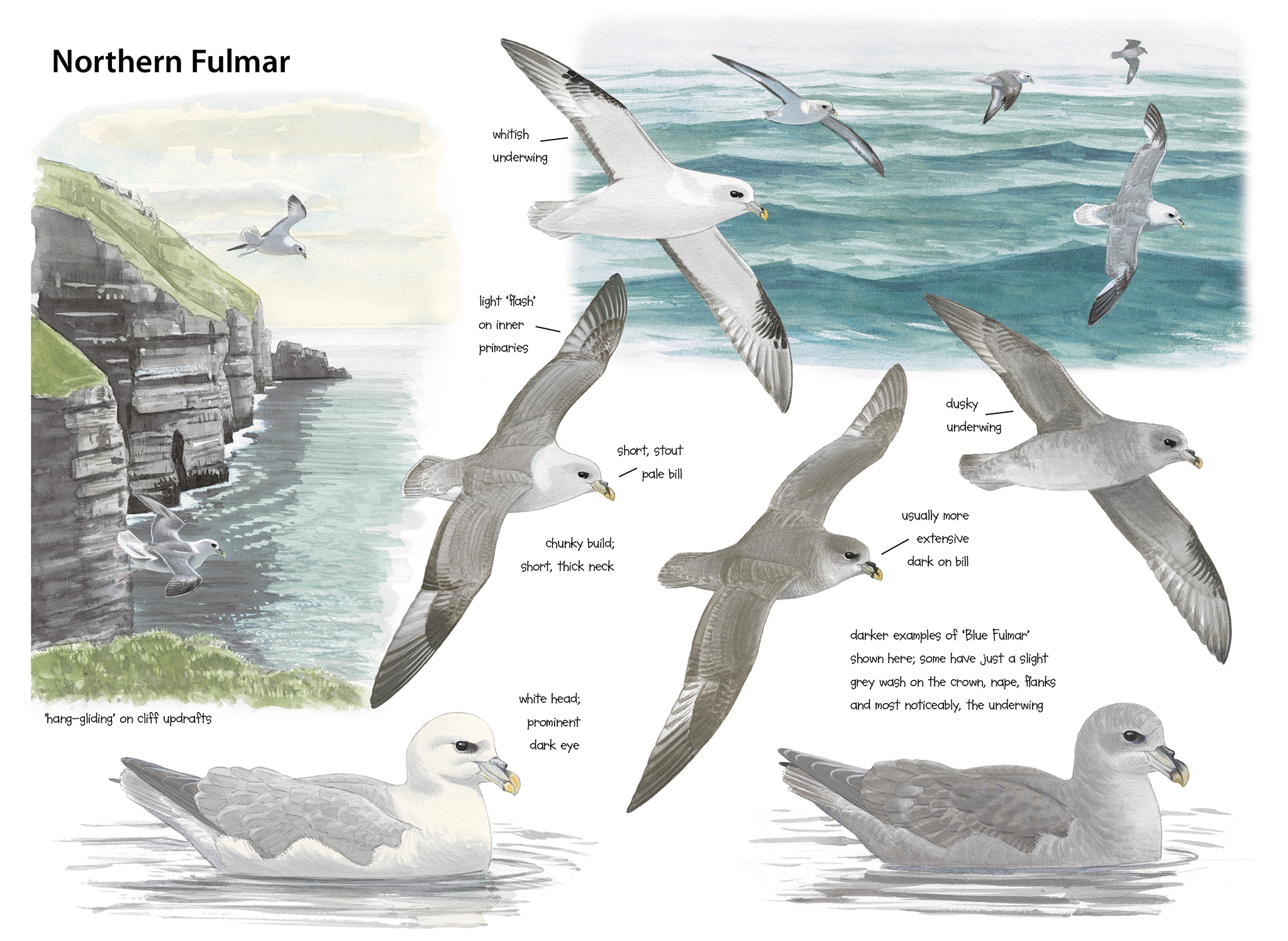
Killian Mullarney
Text by Magnus Robb.
Of all petrels, Northern Fulmar Fulmarus glacialis inhabits the highest latitudes. Its breeding range extends to the High Arctic, reaching parts of Greenland less than 10 degrees from the North Pole. Yet, from an evolutionary perspective, the fulmar is a southerner. All the other six fulmarine petrels are indigenous to the southern oceans: the Antarctic Petrel Thalassoica antarctica, Cape Petrel Daption capense, Southern Macronectes giganteus and Northern Giant Petrels M halli, Snow Petrel Pagodroma nivea and Southern Fulmar F glacialoides. Five of them actually breed on the Antarctic continent. The Snow Petrel even nests up to 440 km inland, on cliffs and steep slopes facing into the bitter Antarctic wind (Goldsworthy & Thomson 2000).
The Northern Fulmar is separated from its southern hemisphere relatives by thousands of nautical miles of tropical and subtropical ocean. Only two southern stragglers – a Cape Petrel and an unidentified giant petrel – have managed to cross these fulmar-unfriendly seas since ornithological records began (Snow & Perrins 1998). During glacial periods of the Pleistocene, the distance between the cold seas of the north and south was much smaller. Voous (1949) argued that Southern Fulmars may have taken advantage of a corridor linking the cold California Current to the Humboldt Current off western South America, which is still cold enough for Galapagos Penguins Spheniscus mendiculus to breed on the equator. During warmer interglacial periods, the cold seas retreated northwards, the Arctic ice cap retreated, and fulmars were able to move along the northern coast of Canada into the Atlantic. According to this scenario, Southern Fulmar is the oldest living representative of the Fulmarus clade, and the Northern Fulmar of the Pacific is ancestral to its Atlantic counterpart.
When it arrived in the far north, the fulmar found an empty niche. In the polar regions, daylight lasts 24 hours during summer, allowing phytoplankton to photosynthesise and reproduce quickly. This provides masses of food for krill and other zooplankton, which in turn support an array of fish, sea mammals and birds. All this is good news for a petrel, but there is a hitch. For most petrels, a lack of darkness means no safety from predators on the breeding grounds. The fulmarine petrels of the Antarctic solved this problem millions of years ago. Their key adaptation was the one that gave them their name. ‘Fulmar’ is a combination of Old Norse ful and mar meaning ‘foul gull’, referring to the habit of spitting foul-smelling stomach oil. All seven fulmars are able to do this in defence, especially before they are able to fly, and the option of flying away from danger is not available. The habit is thought to have evolved from regurgitating food to escape predators, something many seabirds do to reduce weight and present an easier, smaller target to their tormentors (eg, jaegers and skuas Stercorarius). Fulmars can spit oil even when there is no food in their stomachs. The habit is so deeply ingrained that a fulmar chick was once observed spitting through a hole in the egg, just large enough for its beak to stick through (Fisher 1952).
I know what it is like to be oiled, and I cannot say I recommend it. In July 2001, I was at Hesta Head on South Ronaldsay, Orkney, Scotland, recording seabirds. Down at the bottom of a steep, grassy slope, I could see a large flat rock where non-breeding Razorbills Alca torda were displaying. Not far away, some Grey Seals Halichoerus grypus were making loud and very unseemly noises. I plucked up the courage to negotiate my way down between the nesting fulmars, and put my microphone a bit closer. Everything was going just fine, until I started climbing back up again. The trouble was that now, from below, I was unable to see the better concealed fulmars until it was too late. Sure enough, one of them hit me square on the shoulder with a dollop of disgusting goo. Remembering my parents’ warnings, many years before, that fulmar oil could ruin your clothes for good, I scraped as much as I could off with a penknife. Only after it had been washed several times was the smell reduced to something I could laugh off as a souvenir. I have no recording of that oiling, but here is a spitting juvenile I recorded one night on St Kilda, Scotland (CD2-01).
CD2-01: Northern Fulmar Fulmarus glacialis St Kilda, Western Isles, Scotland, 23:29, 23 July 2007. Defensive spitting of a young fulmar that was lying on soft grass and had apparently fallen out of its nest. Background: cackling of individuals on their breeding ledges above. 070723.MR.232900.00
Northern Fulmars are by no means restricted to the Arctic. They breed as far south as Brétagne (Brittany), France, in the eastern Atlantic, and Newfoundland, Canada, in the west. It is easy to forget that 200 years ago fulmars lived on just two islands in the temperate North Atlantic. From written records and excavations of human settlements, we know they have bred on St Kilda, 64 km beyond North Uist in the Outer Hebrides, since about 800 AD, while Grímsey, a small island straddled by the Arctic Circle, lying 40 km off the northern coast of Iceland, has held fulmars since at least 1640. The colonisation of other parts of western Europe began with the spread from Grímsey to other parts of Iceland from around the middle of the 18th century. Fulmars then spread to the Faeroes between 1816 and 1839, and were breeding on Foula, Shetland, by 1878. Gradually, the other Scottish islands were colonised, and fulmars spread south, increasing at a rate of about 13-19% a year until 1939, but more slowly in later decades (Burg et al 2003, Fisher 1952). They started breeding in Brétagne in 1960 and even on Helgoland, Germany, in 1972 (Cramp & Simmons 1977). In the western Atlantic, new colonies were established in south-western Greenland, Newfoundland and Labrador in the early 1970s (Hatch & Nettleship 1998).
The amazing history of Northern Fulmar expansion in the boreal Atlantic was chronicled in a book by James Fisher (1952). At least 2378 sources were used to research it, which speaks volumes about the interest with which the fulmar’s spread was followed. There is a particularly enjoyable chapter about St Kilda, where fulmars were of vital importance to the inhabitants for hundreds of years, until the island was abandoned in 1930. Fulmar meat was dried in special huts called cletts, with dry stone walls that let through the wind and a turf roof that kept out the rain. This way, fulmars sustained the islanders until the arrival of spring and fresh eggs. Their stomach oil was poured into a bag made from the dried and blown-out gut of a gannet, simply by tipping the bill of a recently deceased fulmar downwards, and giving the bird a gentle squeeze. It could be used for lighting lamps, or traded for stores from the mainland. About 100 to 130 young fulmars per person were killed, and the human population varied from 200 in the early 1700s to about 32 just before the island was abandoned. When the island’s human population was at its peak, the fulmars were able to sustain a harvest of at least 20 000 young each year.
Despite the abundance of Northern Fulmars and the wealth of documentation about them, very little has been written about their sounds. Fisher reproduced 35 descriptions and 26 onomatopoeic renditions from literature published between 1767 and 1947. He arranged the latter alphabetically and then, just for fun, wrote a composite of them all. Imagine a trio of fulmars “discussing” the ownership of a nest-site in “fantastic, ecstatic” sounds. Fisher’s rendition –
aaark-ag-ah-ak-arrr-brrae-buck-caw-cok-coo-eck-ga-gä-gaggeragaggagagga-gagagagaga-gah-gerrr-grorr-grrr-ha-haw-hough-i-kaka-karo-kekerek-kertchük-kokokok-kraw-kuh-kurr-kwakwakwa-oh-ok-ork-r-rherrrrrr-roo-tchück-uä-ug-uh-uk-urg-urk-wib
– gets as near to the “cawing, croaking, rolling throaty sounds” as it seemed possible to him at the time. Now listen to a recording of a trio on Skellig Michael, Ireland, perhaps at a lower pitch of emotion, and see if you think he got it right (CD2-02). The recording was made by using a fishing rod to lower the microphones slowly onto a ledge where some non-breeding individuals were displaying.
Fulmars’ oil-spitting defence against predators has allowed them not only to visit their colonies in broad daylight, but also to nest on ledges, rather than down burrows or hidden away in a crevice. Because of this, we can see a great deal of their behaviour, and gain some insights into their social life. It turns out that they love visiting one another on their ledges. A typical scene at a colony is one of many stiff-winged fulmars sailing along the cliffs, while others occupy spaces on the ledges, 1-2 m apart. Every now and then, a fulmar alights on a ledge, typically where one or more other individuals are already present. The hosts usually cackle vigorously, sweeping their heads from side to side, while the visitor is passive, sitting erect with its head up, before possibly bowing and cackling in response to the hosts. Fulmars are long-lived birds, and we know this because like most petrels, they are highly faithful to their breeding site. Several adults ringed in 1951 on Eynhallow, Orkney, were still breeding in 1990, by which time they were probably over 50 years old (Dunnet 1991). So, ledge visits probably play an important role in getting to know long-term neighbours, as well as establishing the social order in the colony (Hatch & Nettleship 1998).
Throughout the breeding season, both hosts and visitors have two main kinds of cackling calls, given almost exclusively on the ground (Pennycuick & Webbe 1959). In the more commonly heard ‘fast cackling’ (eg, CD2-02), a series of short, exhaled kok notes, up to 10 per second, alternate with longer, inhaled and deeper aawww notes. Sometimes, when the short exhaled notes get to a certain threshold speed, the fulmar seems unable to speed them up any more, and lumps them into a longer, emphatic craaark.
CD2-02: Northern Fulmar Fulmarus glacialis Skellig Michael, Kerry, Ireland, 20:13, 26 August 2006. Fast cackling of three individuals on a ledge. 060826.MR.201325a.00
After my microphones had been hanging from the fishing rod for about half an hour, two fulmars joined the original occupant on its ledge, and bouts of fast cackling were occurring at intervals of about a minute or so. But there were also some louder outbursts. ‘Slow cackling’, also known as ‘braying’, is a display of vigour in which two kinds of longer notes alternate: a loud AAARK and a quieter, shorter aww. There are only up to three (or exceptionally four) loud notes per second, hence ‘slow’. In fact, the respiratory cycle is much quicker than in fast cackling, because the AAARK is exhaled and the aww is inhaled. Such a rapid breathing cycle requires greatly increased airflow. Probably because slow cackling is expensive to produce in energy terms, it tends to be used sparingly. In CD2-03, a bout of slow cackling starts at 0:43.
CD2-03: Northern Fulmar Fulmarus glacialis Skellig Michael, Kerry, Ireland, 20:17, 26 August 2006. Fast and slow cackling of three fulmars on a ledge. The slow cackling comes towards the end. Background: Black-legged Kittiwake Rissa tridactyla. 060826.MR.201325b.00
Northern Fulmar calls are a good example of a ‘graded’ repertoire. Rather than having two or three fixed calls, a basic set of sounds is used in a flexible way. Fast cackling is constantly varied in its loudness and speed of delivery, as well as the number of kok notes between breath notes. Slow cackling is equally variable, and it can suddenly commence and subside again during a bout of fast cackling. It is also possible to trace a line of increasing excitement and airflow, from quiet fast cackling with few kok notes, to louder fast cackling with more kok notes, to fast cackling where the kok notes fuse into craaark notes, to slow cackling where each AAARK note is preceded by its own mini breath. This flexibility in the structure of its calls allows the fulmar to display a wide range of emotions, conveying many possible different messages with a small repertoire of basic sounds.
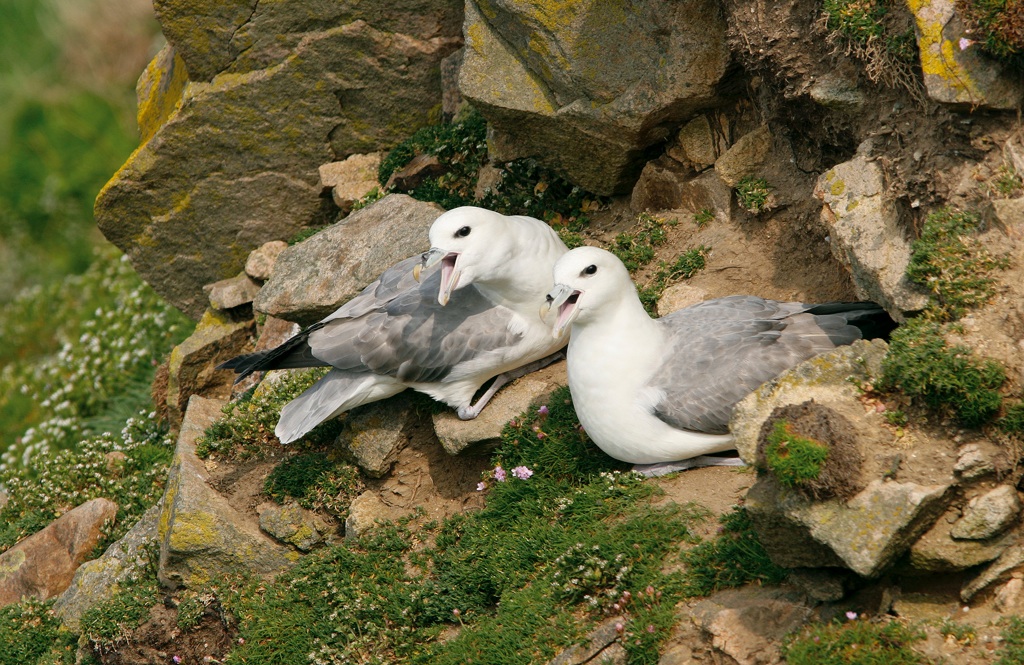
Northern Fulmars Fulmarus glacialis, Great Saltee Island, Wexford, Ireland, 14 April 2007 (Killian Mullarney)
Fulmars also have an important visual component in their displays. Cackling usually forms part of a display called head-sweeping. In pairs, this can be started by either bird; the other usually joins in soon afterwards. The head is moved slowly from side to side while also being bowed up and down, and cackling emanates from the wide open bill. At the same time, the neck and throat are inflated, and the mauve or pink mouth cavity is exposed (Warham 1996). The female passes her bill between the open mandibles of the male, and cackling is sometimes also accompanied by mutual bill fencing and allopreening, in which passive and active roles may be frequently reversed (Hatch & Nettleship 1998).
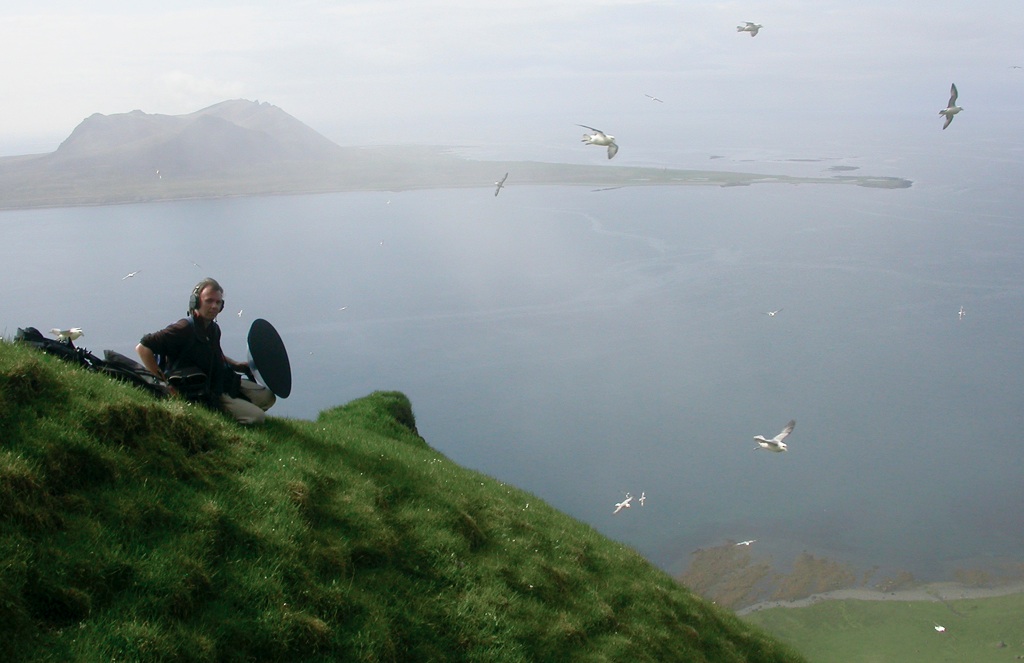
Magnus Robb sound-recording Northern Fulmars Fulmarus glacialis, Bjarnarhafnarfjall, Vesturland, Iceland, 19 June 2003 (Gunnar Thór Hallgrímsson)
Although head-sweeping and cackling are often exchanged between pair members, the pair may display collectively to a visitor. The message understood will depend not only on the type and loudness of the cackling, but also on how it is modified by body language. Head-sweeping with raised neck feathers is an aggressive display, whereas head-sweeping without them is not. When a visitor is unwelcome on the ledge, slow cackling becomes higher pitched, faster and more raucous than at other times, as can be heard at the start of CD2-04. To get rid of the visitor, a host may lunge towards it or give retching sounds, threatening to spit oil. This rarely fails to get rid of the unwelcome guest.
CD2-04: Northern Fulmar Fulmarus glacialis Kirkjufell, Vesturland, Iceland, 00:30, 21 June 2003. A large mixed colony of fulmars and Glaucous Gulls Larus hyperboreus, in the middle of the shortest ‘night’ of the Icelandic summer. High-pitched slow cackling can be heard at the start, and there are several series of low moans by fulmars in flight. 03.028.MR.11054.00
In early spring, visits between fulmars in the colony take on a whole new meaning. Fulmars, it seems, are among the most promiscuous of petrels. Males are always on the lookout for opportunities to sow their wild oats. By visiting females other than their mate, they try to distribute their genes across more than one breeding attempt. It is not just the males that are up to no good. Scott Hatch, who studied extra-pair copulations in Alaskan fulmars during the 1980s, recorded just as many visits by unfaithful females to males as he did males to females (Hatch 1987). Extra-pair visits lasted anything from less than a minute to more than an hour, and in a few instances when partners were out at sea, unpaired males and female neighbours would spent an entire day or more together, behaving as if they were a pair. More often than not these were neighbours, and this suggests that their ‘illicit’ relationships could be of very long duration, some even lasting for decades.
Hatch noticed that males who were trying to gain the confidence of a female other than their mate used a special display, which he called the ‘extra-pair courtship display’. During this display, intermittent short bursts of cackling are directed at the female. These last just 1-2 seconds, and are spaced at fairly regular intervals, ranging from about 3-8 seconds, depending on the intensity. This display, which can be performed continuously for 10-20 minutes and occasionally longer, has only been noted during the period of copulation, which peaks just under a month before egg-laying (ie, mid-April in boreal European fulmars), and ceases entirely by about nine days before egg-laying, by which time most females are away on their pre-laying exodus anyway (Hunter 1998). Unfortunately, I have no recordings of this call type, because I have not visited a colony at the right time of year.
Extra-pair copulation calls are also of interest because these are thought to be the only calls not shared by both males and females. Any fulmar heard giving them has to be a male. It remains to be discovered whether any other Northern Fulmar calls can be used in sexing, but males are known to have lower pitched calls in at least two other fulmarine petrels: Snow Petrel (Guillotin & Jouventin 1980) and Cape Petrel (Warham 1990). On the other hand, fulmars can see each other clearly at their colonies, and physical differences between the sexes may release them from the need for sexually dimorphic calls. No such calls have been discovered in the Southern Giant Petrel, whose voice has been studied more closely than that of any other fulmarine petrel. Warham (1996) suggested this was because the huge male bill left little room for misunderstandings. Northern Fulmars are much less sexually dimorphic than giant petrels in their appearance, but males do have larger heads and bills, and a longer tarsus (eg, van Franeker & Ter Braak 1993, Mallory & Forbes 2005).
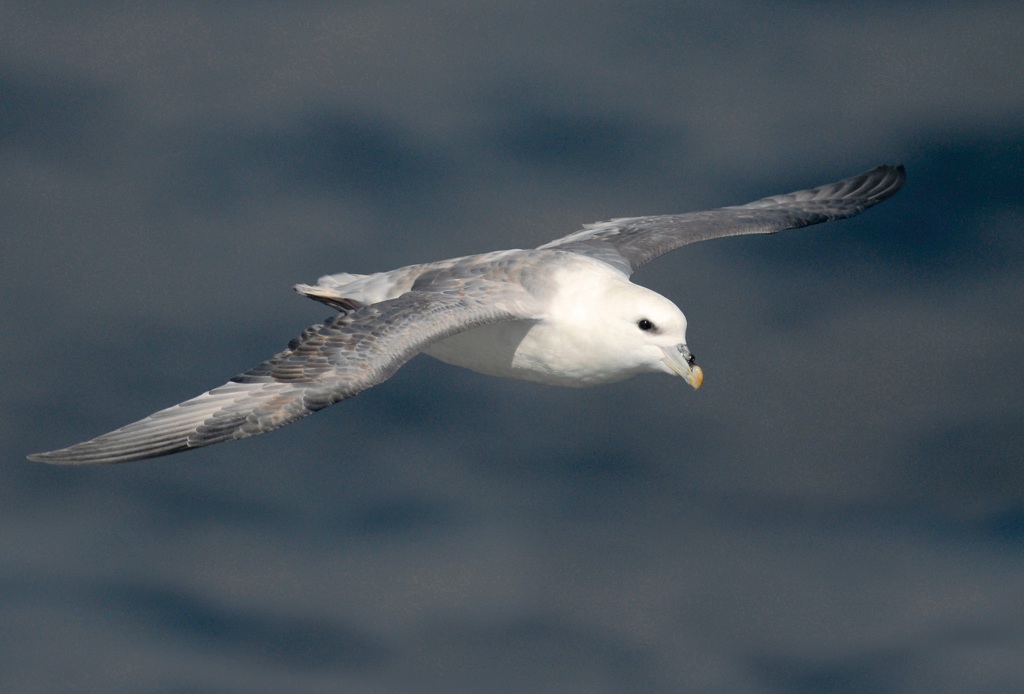
Northern Fulmar Fulmarus glacialis, off northern Spain, 29 August 2007 (René Pop)
Kirkjufell, one of the most famous mountains in Iceland, is named for its similarity to a tall, narrow church. In June 2003, I climbed halfway to its summit with Gunnar Thór Hallgrímsson, to make recordings in a Glaucous Gull Larus hyperboreus colony. The gulls share the site with fulmars, which I could always hear in the background of my recordings. It was at Kirkjufell that I first noticed some rather quiet sounds of fulmars in flight. The first was a kind of sneeze, which can be given either by flying or perched fulmars, and is no different from the one illustrated for Fea’s Petrel Pterodroma feae (CD1-08). Pennycuick & Webbe (1959) heard the same sound on Svalbard, and concluded that it was given when a fulmar was surprised: “for example when one gliding steadily along a cliff top is suddenly confronted by a human being and swerves to avoid him”. Pennycuick also heard repeated sneezes from a fulmar hovering in an updraught, close to its nest, leading him to believe it was a mild form of mobbing. I believe that the sneeze is nothing more than the sound of clearing the salt glands through the ‘nosetube’ sitting atop the bill. It probably has little or no communicative significance, and in surprised fulmars, it may just be a kind of distraction behaviour.
The other sound I have heard when fulmars fly past is a quiet, simple call usually repeated in short series, at just over one per second. The call varies in length from a moan to a short, sharp grunt, and Pennycuick & Webbe (1959) have noted that in very calm conditions a rasping inhalation note can sometimes be heard between moans. Several variants can be heard from two individuals in CD2-05, part of a three-minute sequence during which short series could be heard no less than 15 times. They can also be heard in the preceding recording, CD2-04. I have no idea what the significance of these calls might be, but being so quiet, they are easily missed. Fisher (1952) described them too, and he was equally lost for an explanation.
CD2-05: Northern Fulmar Fulmarus glacialis Kirkjufell, Vesturland, Iceland, 01:00, 21 June 2003. Calls of two individuals in flight, during the shortest ‘night’ of the Icelandic summer. Background: Glaucous Gulls Larus hyperboreus. 03.028.MR.12013.00
In CD2-06, you can hear a fulmar nestling again, not spitting this time but begging. These rapidly repeated, rather harsh croaks are one of the most characteristic sounds of fulmar colonies from July onwards. Begging calls are used to initiate a feeding bout, and you can often see how they seem to stimulate muscle contractions in adults, leading to regurgitation of food (Hatch & Nettleship 1998).
CD2-06: Northern Fulmar Fulmarus glacialis St Kilda, Western Isles, Scotland, 23 July 2007. Begging calls of a nestling while one of its parents was present at the nest. Background: St Kilda Wren Troglodytes troglodytes hirtensis. 070723.MR.062007.00
I have never heard recordings from the High Arctic, where fulmars vary in appearance from their temperate conspecifics. In most High Arctic colonies in the Atlantic (eg, Bear Island, Svalbard, Franz Josef Land, north-eastern Greenland and Baffin Island) there is a high percentage of dark-morph ‘blue fulmars’. Pale-morph, short-billed fulmars breed at all these locations too, and both tend to have rather short bills. The fulmars of Jan Mayen and north-western Greenland are almost exclusively pale morphs. Any attempt to define taxa based on these characters is bound to be unsatisfactory, as some populations cannot be assigned to either (van Franeker & Wattel 1982).
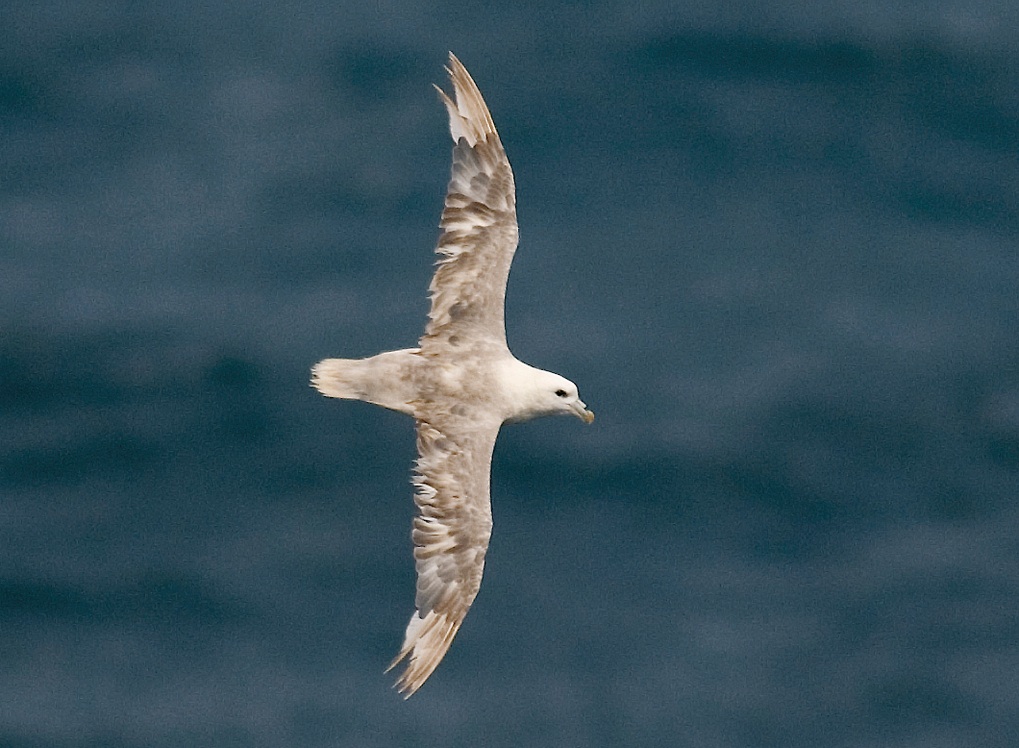
Northern Fulmar Fulmarus glacialis, very worn, off northern France, 26 August 2007 (René Pop)
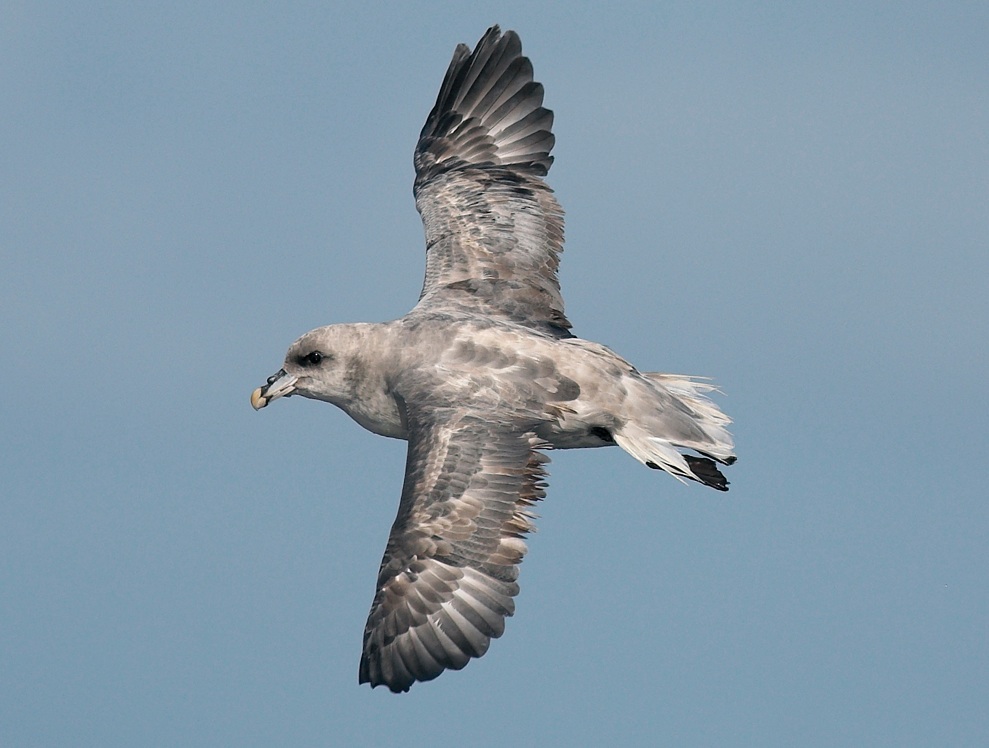
‘Blue Fulmar’ Fulmarus glacialis, Tory Island, Donegal, Ireland, 11 September 2007 (Anthony McGeehan)
There have been various attempts to explain the ‘colour phases’ in relation to rainfall, air temperature and sea temperature. None of these really work. The variation in bill size obeys Allen’s rule, which predicts that extremities should be shorter in cold environments to minimise heat loss. But the existence of a dark morph in the Arctic contradicts Gloger’s rule, which links darker pigment to higher humidity and temperature. Strangest of all, the ‘colour phases’ are reversed at similar latitudes in the Pacific, where dark fulmars breed to the south of pale ones. Dark-morph fulmars in the Pacific are even darker than ‘blue fulmars’ of the Atlantic, while pale-morph Pacifics are lighter than Atlantic ones. Their distribution at reversed latitudes in the Atlantic led van Franeker & Wattel (1982) to suggest that there had been two separate colonisations from the Pacific. The presence of two ‘colour phases’, as well as every variety in between them was the result of their subsequent mixing.
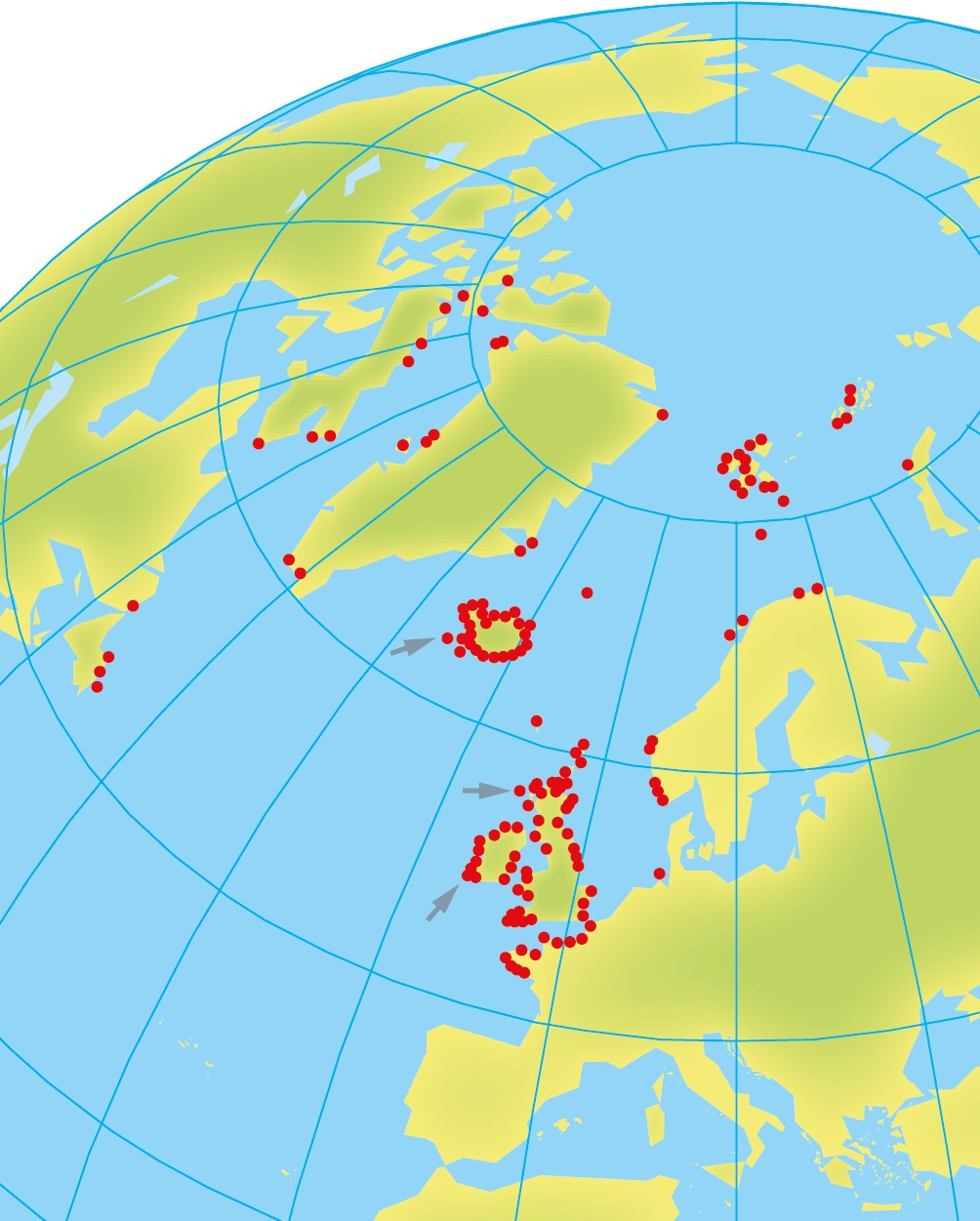
Northern Fulmar Fulmarus glacialis: known Atlantic breeding distribution (red dots).
Recording locations indicated by arrows (north to south):
Kirkjufell, Vesturland, Iceland;
St Kilda, Western Isles, Scotland;
Skellig Michael, Kerry, Ireland.
I have no reason to expect that High Arctic fulmars sound much different from the ones I have recorded, although a shorter bill might have an effect on their sound. Different sounding or not, it would be thrilling to hear them bickering with Ivory Gulls Pagophila eburnea and roaring Polar Bears Ursus maritimus, at a whale carcass stranded on a Svalbard reef. Not that more southerly locations are lacking in spectacle or danger when it comes to recording petrels. An oiling could be considered a reasonable price to pay to record marvellous seabirds like fulmars. But how exciting must the bird be for a sound recordist to risk being marooned on a desert island or, worse still, shipwrecked?
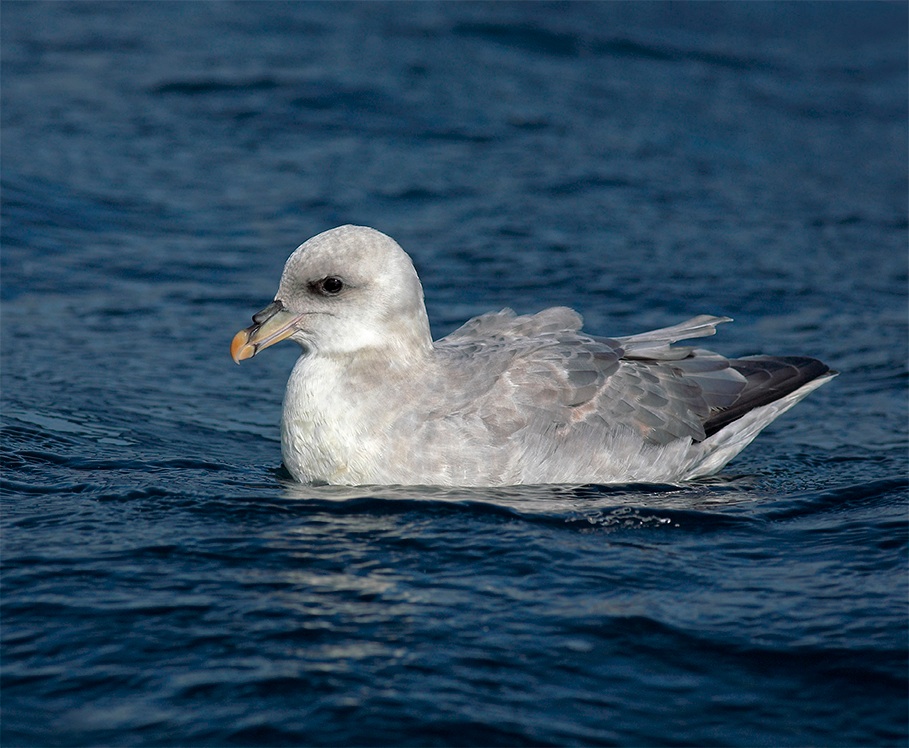
‘Blue Fulmar’ Fulmarus glacialis, Tory Island, Donegal, Ireland, 11 September 2007 (Anthony McGeehan)

